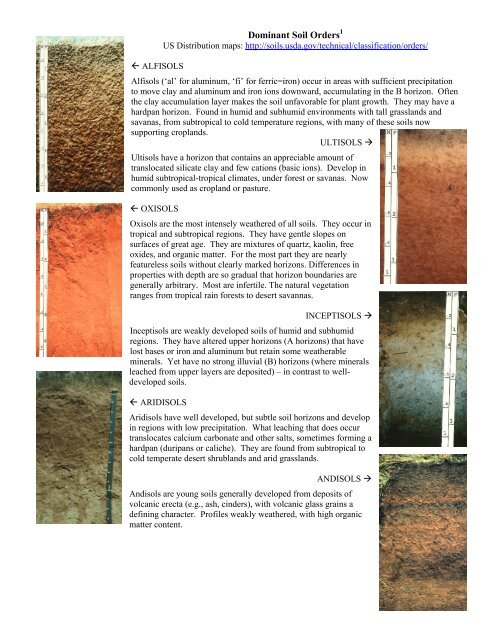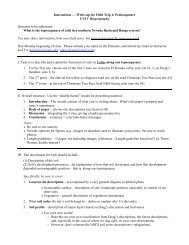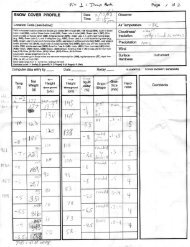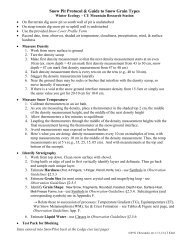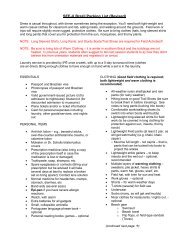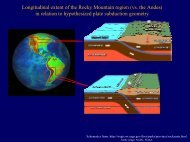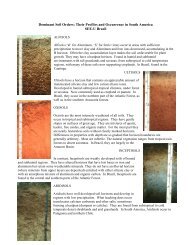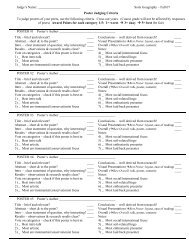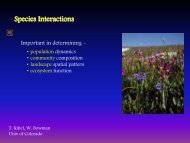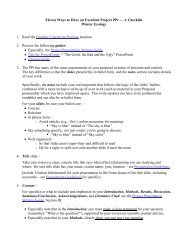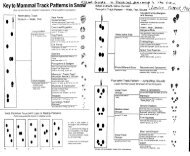Dominant Soil Orders1
Dominant Soil Orders1
Dominant Soil Orders1
Create successful ePaper yourself
Turn your PDF publications into a flip-book with our unique Google optimized e-Paper software.
ALFISOLS<br />
<strong>Dominant</strong> <strong>Soil</strong> Orders 1<br />
US Distribution maps: http://soils.usda.gov/technical/classification/orders/<br />
Alfisols (‘al’ for aluminum, ‘fi’ for ferric=iron) occur in areas with sufficient precipitation<br />
to move clay and aluminum and iron ions downward, accumulating in the B horizon. Often<br />
the clay accumulation layer makes the soil unfavorable for plant growth. They may have a<br />
hardpan horizon. Found in humid and subhumid environments with tall grasslands and<br />
savanas, from subtropical to cold temperature regions, with many of these soils now<br />
supporting croplands.<br />
ULTISOLS <br />
Ultisols have a horizon that contains an appreciable amount of<br />
translocated silicate clay and few cations (basic ions). Develop in<br />
humid subtropical-tropical climates, under forest or savanas. Now<br />
commonly used as cropland or pasture.<br />
OXISOLS<br />
Oxisols are the most intensely weathered of all soils. They occur in<br />
tropical and subtropical regions. They have gentle slopes on<br />
surfaces of great age. They are mixtures of quartz, kaolin, free<br />
oxides, and organic matter. For the most part they are nearly<br />
featureless soils without clearly marked horizons. Differences in<br />
properties with depth are so gradual that horizon boundaries are<br />
generally arbitrary. Most are infertile. The natural vegetation<br />
ranges from tropical rain forests to desert savannas.<br />
INCEPTISOLS <br />
Inceptisols are weakly developed soils of humid and subhumid<br />
regions. They have altered upper horizons (A horizons) that have<br />
lost bases or iron and aluminum but retain some weatherable<br />
minerals. Yet have no strong illuvial (B) horizons (where minerals<br />
leached from upper layers are deposited) – in contrast to well-<br />
developed soils.<br />
ARIDISOLS<br />
Aridisols have well developed, but subtle soil horizons and develop<br />
in regions with low precipitation. What leaching that does occur<br />
translocates calcium carbonate and other salts, sometimes forming a<br />
hardpan (duripans or caliche). They are found from subtropical to<br />
cold temperate desert shrublands and arid grasslands.<br />
ANDISOLS <br />
Andisols are young soils generally developed from deposits of<br />
volcanic erecta (e.g., ash, cinders), with volcanic glass grains a<br />
defining character. Profiles weakly weathered, with high organic<br />
matter content.
MOLLISOLS <br />
Mollisols have a dark-colored, organic-rich surface horizon (A horizon) and are found<br />
largely in grasslands. They occur from tropical to cold temperate, and from subhumid<br />
to semiarid environments.<br />
SPODOSOLS<br />
Spodosols have moderately acidic sandy profiles with an ashywhite<br />
upper horizon. In these soils, amorphous mixtures of<br />
organic matter and aluminum, with or without iron, have<br />
accumulated. They are typical of sandy soils under cool, wet<br />
conditions under conifer and hardwood forests such as in the<br />
boreal/cold temperate forests of Canada.<br />
GELISOLS <br />
Gelisols are soils that have permafrost within 100 cm of the soil<br />
surface and/or have gelic materials within 100 cm of the soil<br />
surface and have permafrost within 200 cm. Gelic materials are<br />
mineral or organic soil materials that have evidence of<br />
cryoturbation (frost churning) and/or ice segeration in the active<br />
layer (seasonal thaw layer) and/or the upper part of the permafrost.<br />
Occur in arctic and subarctic regions. Permafrost influences<br />
pedogenesis through its effect on the downward movement of the<br />
soil solution and on the soil forming processes.<br />
HISTOSOLS<br />
Histosols are dominantly organic. They are mostly soils that are<br />
commonly called bogs, moors, or peats and mucks. A soil is<br />
classified as Histosols if it does not have permafrost and is<br />
dominated by organic soil materials.<br />
ENTISOLS <br />
Entisols are recent soils with little or no profile development. At<br />
the most, have a weak organic matter surface layer (O horizon).<br />
Include deep, uniform sandy aeolian deposits (pictured here) to<br />
complex fluvial deposits. Some Entisols have steep, actively<br />
eroding slopes, and others are on flood plains or glacial outwash<br />
plains that frequently receive new deposits of alluvium.<br />
VERTISOLS<br />
Vertisols have a high content of expending clay and that have at<br />
some time of the year deep wide cracks. They shrink when drying<br />
and swell when they become wetter.<br />
______________<br />
1 Descriptions and images from–<br />
- NRCS http://soils.usda.gov/technical/classification/orders/ (Accessed 6/13/04)<br />
- Brady NC. RR Weil. 2008. The Nature and Properties of <strong>Soil</strong>s. Prentice-Hall. Ch 3.<br />
- Donahue, RL, R Miller, J Shickluna. 1983. <strong>Soil</strong>s: An Introduction to <strong>Soil</strong>s and Plant<br />
Growth. 5th Ed. Prentice-Hall.<br />
Other resources –<br />
http://soils.cals.uidaho.edu/soilorders/orders.htm<br />
http://soils.ifas.ufl.edu/faculty/grunwald/teaching/e<strong>Soil</strong>Science/soil_orders.shtml<br />
T.Kittel 604, 211


